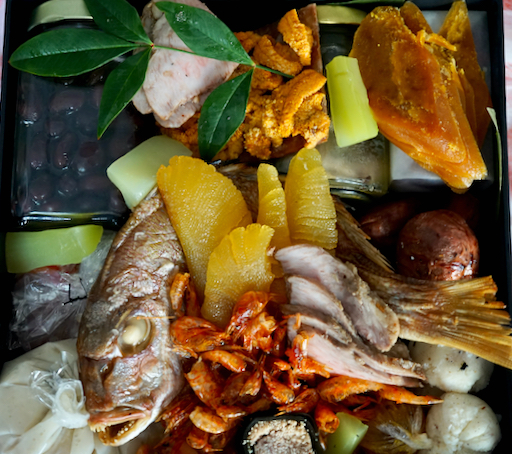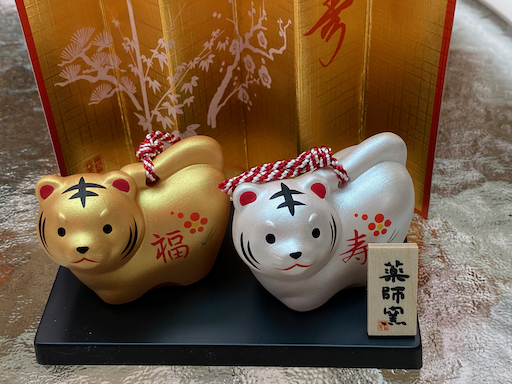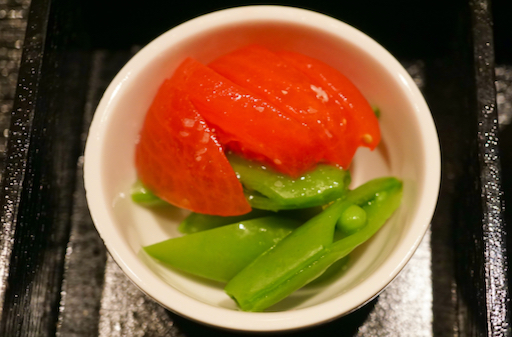Friday, January 17, 2025
Bottarga/Karasumi Taste Test 日本の唐墨とサルジニアのボタルガの味比べ
Tuesday, January 14, 2025
“Karasumi” Japanese Bottarga from Maruhide 丸秀の唐墨
*Digression alert: I already pontificated about “Karasimi” that it is originally from Sardinia which came into southern Japan during the edo-period and that the shape of bottarga to Japanese was reminiscent of “sumi” ink block from China hence the name “kara-sumi” in which “kara” 唐 means “China” (more precisely Tang-dynasty) and “sumi” means “ink”. We really like karasumi which is a regular part of the “osechi” box from Sushi taro. Karasumi is also associated with a fond memory of when we were in Japan last time in fall. Because of the approaching typhoon we left Sapporo one day earlier and stayed in a hotel near Narita airport. We went to a sushi bar in the hotel for dinner and a drink. It was not crowded. We tried to sit at the sushi bar where an old couple was already seated. Although the rest of the restaurant was empty there was a “reserved” sign on the sushi bar. When we indicated we would like to sit at the bar, a waitress told us the bar was a “no set menu order, a la carte only” in English. To that I reply in Japanese that it was fine with us. After a quick look of surprise the waitress ushered up to our seat at the sushi bar. So we sat and a very friendly sushi chef came greeted us and asked where we were from. Once he found we were from Washington, DC areas, he beamed and said “The Nationals!” (he was a big baseball fan). I asked for “otsumami” drinking snacks of his choice (i.e. omakase) first. Several sashimi were served and he said they had “karasumi” so we ordered it. It was very nice and served slightly toasted. The old couple appeared “surprised” at our ordering karasumi (in such close quarters with only two customers we were all aware of what each other was eating) and that my wife enjoyed it. So they also ordered some too.
Wednesday, January 1, 2025
Table of Contents 2025
January 2 Happy New Year 2025 謹賀新年2025
January 5 Sushi Taro Osechi box 2025
January 8 Sushi Taro New Year Soba 手打ち蕎麦
January 11 Grilled “Tai” Perch Seasoned Rice 鯛飯もどき
January 14 “Karasumi” Japanese Bottarga from Maruhide 丸秀の唐墨
January 17 Bottarga/Karasumi Taste Test 日本の唐墨とサルジニアのボタルガの味比べ
January 20 Apple Pie Muffin and Pan Cake アップルパイ マフィン
January 23 “Endless” Konnyaku 無限コンニャク
January 26 Mock Tofu 擬制豆腐
January 29 Apple Fritter アップルフリッター
February 2025
February 1 Braised Eggplant with Ground Chicken 茄子のそぼろ煮
February 4 Sashimi Daikon Garnish 刺身の大根つま/けん
February 7 Wild Rice Salad ワイルドライスサラダ
February 10 Apple Pie Muffin Made with Juiced Apple アップルパイマフィン
February 13 Chocolate Milk Bread チョコレートミルクパン
February 19 Ricotta Lemon Cookie リコッタチーズ レモンクッキー
February 21 Assorted Japanese Mini-pans 日本のミニ菓子パン各種
February 24 Quesadilla with Mini-corn Tortilla and Browned Cheese
February 27 Burdock Root Kelp Roll ごぼうの昆布巻き
March 2025
March 2 Anchovy Onion Cocktail Biscuit アンチョビイと玉ねぎカクテルビスケット
March 6 Shrimp Chicken Gyouza エビと鶏肉の餃子
March 9 Chickpea fries ひよこ豆フライ
March 19 Babka Cookie Muffin バブカ クッキー マフィン
March 22 Nappa Cabbage Cream Stew 白菜のクリームシチュー
March 30 Jubako for “hanami” cherry blossom gazing 花見用市松模様の重箱
April 2025
April 2 Hanami 2025 花見2025
April 5 Hanami #2 花見#2
April 8 “Cotton Candy Grape Muffin” “わたあめブドウ” のマフィン
April 11 “Cotton Candy Grape” Panna Cotta “わたあめブドウ“ パンナコッタ
April 14 Carrot Salad Muffin 人参サラダ入りマフィン
June 2025
June 12 Tokyo Kyobashi Areas Izakayas (part 1) 東京の居酒屋 東京駅八...
June 15 Cream Cheese with Pickled Daikon クリームチーズ 沢庵入り
June 18 Tokyo Kyobashi Areas Izakayas (part 2) 東京の居酒屋 東京駅八...
June 21 “Renkon” Lotus Root in sweet vinegar 酢れんこん
June 24 Tokyo Kyobashi Areas Izakayas (part 3) 東京の居酒屋 東京駅八...
June 27 Lemon Crumb Bar レモンクラムバー
June 30 Tokyo Kyobashi Areas Izakayas (part 4) 東京の居酒屋 東京駅八...
July 2025
July 3 Matcha Almond Pancake (again) 抹茶アーモンドパンケーキ
July 6 Izakaya in Kanazawa 金沢の居酒屋
July 9 Topping of Katsu-Don カツ丼のあたま
July 12 Kyoto Izakaya in Kyoto Station area part 1 京都駅付近の居...
July 15 Vinegar Cured Mackerel Sushi with Shiro-ita Kelp バッテラ
July 18 Kyoto Izakaya in Kyoto Station Area Part 2 京都駅駅付近付...
July 21 Pea, Ricotta ad Mint Gazpacho えんどう豆、リコッタチーズとミントのガス...
July 24 Tottori Izakaya and Shinkansen “Izakaya” 鳥取の居酒屋と新幹...
July 27 Pea, Avocado and Mint Blini グリーンピー、アボカド、ミント ガスパッチョ
July 30 Izakaya in Sapporo Part 1 札幌の居酒屋パート1
August 2025
August 2 Chilean Sea Bass in Sweet “Saikyo” Miso メロの西京味噌焼き
August 5 Izakaya in Sapporo Part2 札幌の居酒屋パート2
August 8 Cream Cheese Muffin クリームチーズマフィン
August 11 Sapporo Lunch Places Part 1札幌の昼ごはん パート1
August 14 Pork Vindaloo with Baby Corn and Edamame ポーク “ビンダル...
August 17 Izakaya in Sapporo Part3 札幌の居酒屋パート3
August 20 Impromptu Eggplant Mushroom Stir-fry 茄子と椎茸のオイスターソース炒め
August 23 Sapporo Lunch places part2 札幌の昼ごはん パート2
August 26 Cold Udon with Sesame Sauce 胡麻ソース和え冷製うどん
August 29 Izakaya in Sapporo Part 4 札幌の居酒屋パート4
September 2025
September 1 Savory Breakfast Mini Cheesecakes ミニチーズケーキ
September 4 Izakaya in Sapporo Part 5 札幌の居酒屋パート5
September 7 Mapo (sort of) Eggplant “麻婆風” 茄子
September 10 Izakaya in Sapporo Part 6 札幌の居酒屋パート6
September 13 Oyster Mushroom and Chiku-wa Stir-fly with Yuzu-ko...
September 16 Cheese Straws チーズツイスト
September 19 Small Dishes or “Sake-no-sakana” 酒の肴
September 21 Prosciutto, dates, and goat cheese bites
September 24 Cabbage and pork belly stir-fry キャベツと豚バラの炒め物
September 27 Scallop fry ホタテのフライ
September 30 Yellow Squash Garlic Bites イエロースクワシュ、ガーリックバイツ
October 2025
October 3 Green Yuzu, “Kinome” Japanse pepper leaves 青柚子と木の芽
October 6 Japanese “Mizu” eggplant Asazuke 水茄子の浅漬け
October 9 Spanish Mackerel dumpling Soup topped with “Kinome...
October 12 Cucumber with Miso Sauces 味噌胡瓜
October 15 Moon gazing 10/6/2025 月見
October 18 Dishes from Yellowfin Tuna Sashimi Block キハダマグロ刺身の柵
Wednesday, November 6, 2024
Hiyaoroshi Sake “Shichi Hon Yari” 七本槍 純米ひやおろし
Monday, July 17, 2023
New Divided Plate and 9 Otoshi Appetizers 9つ仕切り皿にのせたお通し9種類
In the 1st row, left, is a sugar snap in salt broth スナップ豌豆の塩びたし. We used to be able to get decent sugar snaps from our regular grocery store but recently, we have had to go to gourmet grocery stores to get decent ones This was crunchy, sweet soaked in salt dashi broth.
In the 1st row, center, are cucumber onion salad and stir fried shirataki, jalapeño pepper and enoki mushroom.
In the 1st row, right, is the cheese curd my wife made but instead of jalapeño pepper, she added “Yuzukosho” 柚子胡椒, soy sauce and cream. I added a dab of yuzukosho on the side to provide an added “schmear” of yuzukosho flavor if desired.
Tsukune on a slice of lotus root 蓮根つくね.
“Uni-shuto” ウニ酒盗 from Maruhide. As I stated before this is the best uni aside from fresh uni. I served it with cucumber and perilla leaves.
I refried the shrimp head kara-age which was part of take-out from Tako Grill a few days ago. Shrimp head has a good amount of meat and is very crunchy but you have to be careful how you eat the prickly legs so as to not injure your mouth.
Recently, we discovered that Whole Foods carries fresh quail eggs. We really like boiled quail eggs. Although we can get canned boiled quail eggs, boiled eggs prepared from fresh quail eggs are much much better. I served it with marinara sauce, basil and sprinkle of salt.
Blanched asparagus with sesame mayonnaise. The dressing is a mixture of mayo, Japanese sesame paste or nerigoma 練りごま and soy sauce.
Salmon salad. My usual. The dressing is mixture of mayo, Greek yogurt and Dijon mustard.
We really like our new plates. If I serve 9 appetizers for two of us in small bowls, we have to wash a total of 18 bowls but here we had to wash only two plates. We really like the many small dishes we had here; true Izakaya-style.
Tuesday, August 30, 2022
Seawater Uni, uni shuto and fresh myoga 海水ウニ、ウニ酒盗、茗荷
Although there is nothing new here, it is not common to have a new crop of myoga 茗荷 harvested from our own garden (just started), fresh salt water (seawater) uni “Kaisui-uni” 海水ウニ and uni-shuto うに酒盗 from Maruhide 丸秀, all available in the same time. Myoga is best enjoyed fresh and the season is rather short and requires some effort to harvest. So, I served a small dish of myoga with cucumber, and wakame as well as two small dishes of each kind of uni. For the occasion, I pulled out the small lidded containers we purchased in Nihiki market, Kyoto 京都錦市場 some years ago.
Tuesday, August 9, 2022
Watari bune Daiginjo 渡船純米大吟醸
This sake “Watari bune, junmai daiginjo” 渡船純米大吟醸 was a gift from a friend for a recent occasion. This is a really great sake with a slightly effervescent feel and fruity, crisp but very complex flavors. This should definitely be drunk cold. This sake is brewed by “Fuchu-homare” 府中誉 which is located in Ibaragi prefecture 茨城県. The sake rice or “sakamai” 酒米 used for this sake is also called “Watari bune” which is supposedly a very rare near-extinct sake rice which relatively recently has been revived. The famous and most popular sake rice “Yamada nishiki” 山田錦 is reportedly a descendant of this rice. Also the name “Watari bune” 渡船, which means a “ferry” or “ferryboat”, is very fitting for sake from Ibaragi which is known for Tone river 利根川 and its estuaries criss crossing the flat delta before pouring into the Pacific ocean.This area also contains large lakes. (Such areas rich in water ways and lakes are called “Suigou” 水郷). Such topography would require use of ferries i.e. “Watari bune” to navigate the water ways.
Tuesday, March 15, 2022
Uni shutou with salmon roe 雲丹酒盗いくら入り
Friday, February 4, 2022
Uni appetizers two kinds 雲丹の前菜2種
As I mentioned previously, Maruhide 丸秀 is the best place to get consistently high-quality uni and uni products. I wanted to get some fresh uni for the New Year. Although I checked the web site regularly fresh uni was not available for some time. So when I saw it became available recently, I could not resist and ordered fresh uni (both regular and in salt water or "Kaisui-uni" 海水うに). I also ordered some "uni shuto " ウニ酒盗 which is preserved and frozen and lasts longer than fresh uni. This is second best (compared to fresh uni) but among the class of "preserved" uni, this is the best by far. We had an uni tasting the evening the uni arrived. It consisted of regular uni and uni in salt water. We also included some ikura like we did before. We finished the evening with a small uni and ikura "donburi" rice bowl 雲丹いくら丼.
The next evening, I made a small uni appetizer dish. Although it is hard to see in the picture, I put cubes of avocado dressed in lemon juice in the bottom of the bowl then topped them with uni, "kinshi-ran" 金糸卵 golden thread egg and nori strips or "kizami-nori" 刻み海苔. I added wasabi-jouyu わさび醤油 (mixture of wasabi and soy sauce just before serving). Since the texure of avocado resembles fatty tuna sashimi, this combination went very well together. The avocado really complemented the uni.
Monday, January 10, 2022
New Year 2022 Jan 3 Salmon three ways 一月三日鮭尽し
We have been enjoying the items from the Sushi Taro osechi box. After indulging in a serving of wonderful dishes from the box which go perfectly with sake, I served this plate as the “second course”. The red and white fish cake or "kouhaku kamaboko" 紅白蒲鉾 (upper left in the picture) came from the osechi box (they were the last four slices). I made a deep pocket in each and stuffed the pink one with the leftover Maruhide sea urchin shutou 丸秀雲丹の酒盗 topped with a dab of wasabi. I topped the white one with Ikura marinated in soy sauce イクラの醤油ずけ topped with strips of nori.
The remaining items were all different salmon dishes which I prepared for New Year. Starting from right upper, clock wise, is salmon nanban 鮭の南蛮漬け、Russian marinated salmon 鮭のロシア漬け, and finally salmon kelp roll 鮭の昆布巻き. These three salmon dishes all have different textures and flavors. For the salmon nanban, the salmon was dredged in flour and fried before being marinaded in sweet vinegar which gave it a bit firmer texture. The Russian marinated salmon started out as thin strips of raw salmon marinated in sake, vinegar and oil without any sweetness. This year I something different. I added dijon mustard to the marinade and emulsified it with the “motor boat” emersion blender. As a result the oil didn’t separate or solidify. Also, the salmon did not “over cook” and had a lovely soft texture. Finally the salmon kelp roll was simmered for sometime in seasoning broth, producing a yet different soft and moist texture. These are wonderful to enjoy with sips of sake.
Friday, January 7, 2022
Sushitaro Osechi 2022 寿司太郎お節 2020
This is a picture of the upper box. I am not going into the details but its all good stuff. Many items are hidden behind and under the items on the top.
This was what we ate from the box the evening of January 2. I just served whatever caught my eye. This round was mainly items that go well with sake.
In this three compartment plate, I served (from left to right) “Mushi uni” 蒸し雲丹 or steamed sea urchin, “Uni shutou with yuzu-chilli” ウニ酒盗 柚子胡椒 from Maruhide 丸秀 and “ikura shouyu-zuke” いくら醤油ずけ soy marinated salmon roe. I added wasabi-soy sauce to the steamed uni and made a cucumber boat to contain the ikura. All perfect for sake.
After these, we had simmered vegetables (again lightly warmed in the microwave) and finished with a mayo-biscuit my wife made that afternoon (subject of another post).
Monday, December 20, 2021
Riviera Seafood Club sashimi リビエラシーフードクラブからの刺身
This is my on-going effort to find retailers where I can get sashimi-grade fish. As I have mentioned previously some of the on-line places like "sushi at home" or "fish for sushi" which sold sashimi fish have come and gone. The good and reliable Catalina Offshore Products is still going strong and we still get occasional shipments of sashimi fish from them. When it comes to Uni うに, Maruhide 丸秀 is the place to go. We have gotten frozen blocks of sashimi-grade tuna from "Great Alaska Seafood" and although it is yellowfin tuna, it is better quality than the frozen yellowfin tuna blocks we got from the Japanese grocery store. Recently I became aware of another vendor called "Riviera Seafood Club" (according to the website it was launched in July 2019, and is family-run). I finally decide to get some akami 赤身 (8oz), chutoro 中トロ (8 oz) and hamachi はまち(8 oz) sashimi from them. Unlike some of the other vendors we have tried, they offered smaller portions which is nice and makes it easier to manage use of the shipment. The chutoro block had one half almost akami and another half of toro. I divided up the block and served the toro part the evening we received the sashimi. The reaming akami was used to make imitation negitoro and cubes of avocado and tuna next evening. The hamachi still had the skin attached which needed to be removed. The picture below shows the serving of the various sashimi.
I think this is a good alternative source of sashimi. It came exactly as they suggested (ordered on Wednesday and arrived on Friday). The only odd thing was that there was no communication. No order confirmation email or shipping notice aside from a text message I received from FedEx concerning expected delivery date.We may try this place again. It is good to know we have more than one place where we can get sashimi.
Sunday, December 5, 2021
Hiyaoroshi #2 and Uni tasting 冷やおろし#2、海水うに
This is a continuation of our exploration of the “Hiyaoroshi” sake ひやおろし we recently acquired (with a complementary uni tasting on the side.) As I mentioned before, this sake is seasonal; only available in autumn and until recently, the only way to enjoy this seasonal sake was to visit Japan in autumn. This fall, however, thanks to Tippsy sake, we could enjoy hiyaoroshi here in U.S. So far, we’ve tried 5 different hiyaoroshi sakes. All of them were “Junmai” class but the aging process really “kicked them up a notch” making them taste superior to regular Junmai sake. All the hiyaoroshi we tasted had rich savory and complex flavors with some fruity floral characteristics. We tasted (from left to right) three sakes; “Ooyama”, “Gokyo” and “Kisoji”.
1. Ooyama 大山 (meaning “big mountain”) is from Yamagata prefecture 山形県 (which is famous for many excellent and “cult” sakes including “Juyondai” 十四代). The brewery is “Katou Kahashirou” 加藤嘉八郎酒造. This sake is called “Tokubetsu junnmai” 特別純米. “Tokubetsu" means “special”. My understanding is that this designation does not have an official definition, but usually the rice is polished to 60%. This is the same level of polishing as “Ginjou” 吟醸酒. So, by definition, this type of “Tokubetsu junmai” could also be sold as “Ginjo”. It is up to the brewer to decide what to call it. Junmai is usually characterized by robust and rich flavors while ginjo is characterized by more elegant crisp fruity flavors. So, depending on the aim of the particular sake, the brewer could call it either way. We really like this sake. Quite rich and dry with some acidity.




























.jpeg)






















